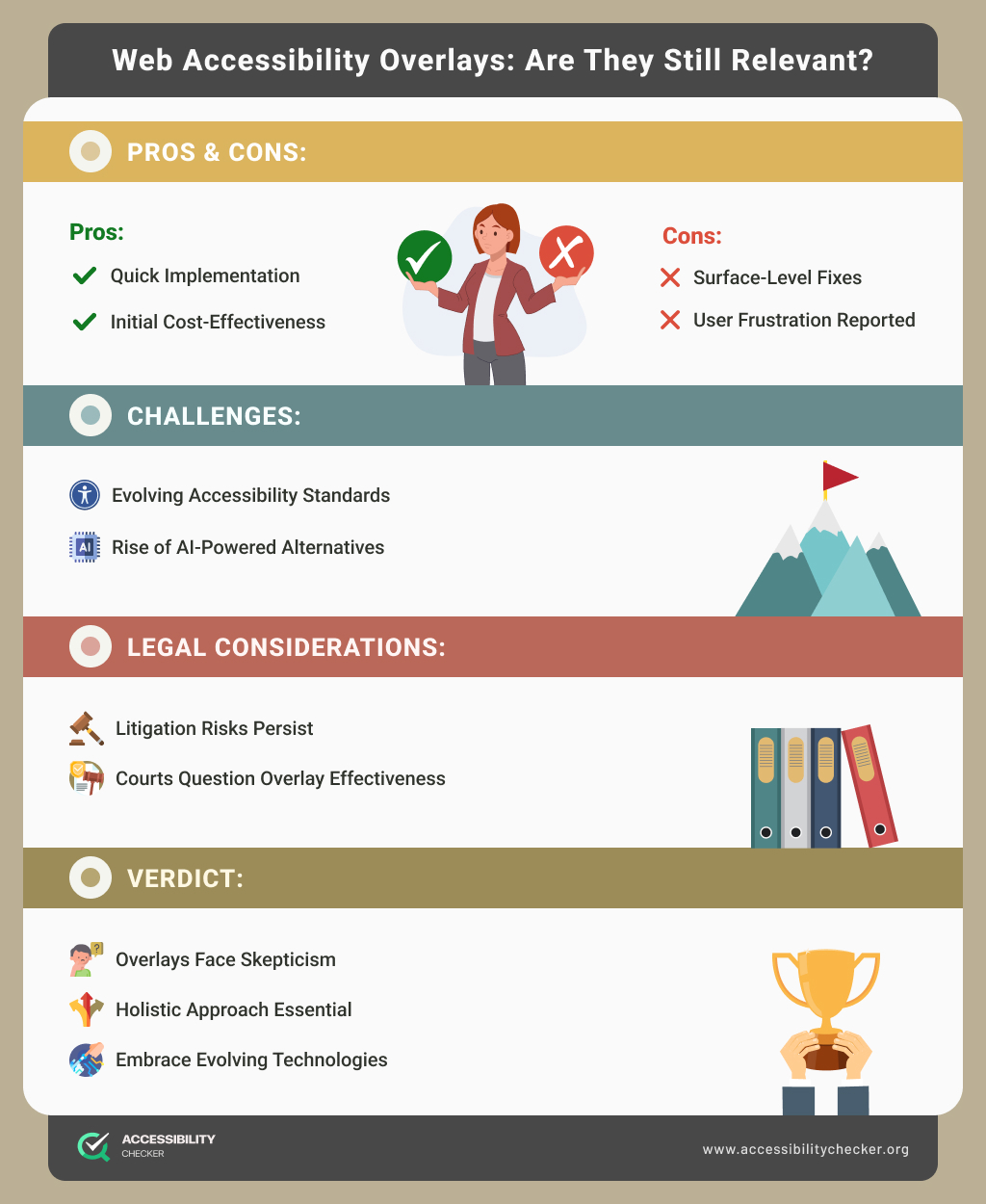accessiBe is one of the most talked-about web accessibility tools available today. It helps take a lot of the manual work out of adhering to ADA and WCAG guidelines by making it quicker and easier to identify web accessibility issues on your site.
Demystifying Web Accessibility Overlays: Are They Still Relevant?
As the number of ADA and web accessibility lawsuits continues to rise, organizations are searching for fast and affordable compliance solutions.
Many vendors have come to the rescue, promising one-click solutions in the form of accessibility overlays.
However, while this might sound ideal to businesses that have little to no web accessibility knowledge, there are a few things to consider before you solely commit to an overlay.
This article will unpack everything you need to know about accessibility overlays and how to make the most of them.

What are Accessibility Overlays?
Web accessibility overlays are automated solutions that are designed to detect and correct accessibility issues on your site. These tools usually come in the form of an app, widget, or plugin and require you to install a line of code on your site to use them.
Accessibility overlays generally don’t alter the source code of your site. Instead, they pick up on common issues such as color contrast and text size and are able to make minor modifications.
Custom overlay solutions are also available, which are tailored to your site’s code and branding. However, your core source code still won’t be altered.
How Do Accessibility Overlays Work?
Web accessibility overlays are powered by AI and machine learning technology and are designed to remove basic accessibility barriers.
An overlay is placed over a website design to provide additional information or execute actions, offering a more inclusive experience for all users, including those with disabilities.
Accessibility overlays were created to benefit both the end user as well as developers.
Developers benefit from the automated functionality of these overlays. Instead of taking the time to manually detect accessibility issues, an overlay will do it for them. The software will also provide specific details on what needs to be fixed and where.
For website visitors, accessibility overlays offer unique customization options based on user preferences. Users can adjust elements such as color contrast, font size, and screen orientation to suit their needs. Most overlays can be accessed by clicking on the universal accessibility symbol that appears in the corner of a site.
Why Overlays Gained Popularity
Accessibility overlays became popular because they offered a quick and inexpensive way for businesses to comply with accessibility standards.
Even though ADA lawsuits are still on the rise, at one point, they were increasing at an alarming rate. Even larger brands such as Dominos were facing lawsuits, prompting businesses to spring into action.
Web accessibility was once still a new topic for many developers, designers, and business owners, hence the need for a solution that was able to fill this knowledge gap.
Vendors took advantage of this need by creating simple solutions that only required a small snippet of code to implement, helping ease the concerns that business owners were now facing.
The Benefits of Web Overlays
Let’s look at a few of the benefits of implementing an accessibility overlay on your site to comply with WCAG guidelines.
Bridging the Accessibility Gap
With the help of AI, web overlays can be a fast and affordable way to bridge any accessibility gaps on your site, especially when you don’t have the time or expertise required for manual testing and remediation.
This is especially true for small-to-medium businesses that don’t have the skills or resources to undertake a manual accessibility project, but still want to cater to consumers with disabilities.
Avoiding Lost Sales
Over 42 million Americans (1) are currently living with a disability. When you consider how many potential consumers you could be isolating, web accessibility quickly makes more sense.
To avoid lost sales and revenue, businesses are turning to accessibility overlays to increase the accessibility and inclusivity of their websites and online stores.
Mitigating Legal Risks
There’s nothing like an ADA lawsuit to bring your business to its knees. Businesses are more aware than ever of the growing risk of costly penalties and lawsuits, hence the need for a fast and affordable accessibility solution.If you’re currently searching for a web overlay solution, we highly recommend accessiBe and UserWay. These tools are some of the most advanced, simple to use, and are easy to integrate with your site.
- WCAG
- ADA
- AODA
- Section 508
- Account managers available to guide you
- 5 min installation
- 100,000+ clients use accessiBe
- Includes accessibility statement and certification
- Built specifically for websites and small and medium-sized businesses (SMBs)- some web apps might not be compatible




- WCAG
- ADA
- AODA
- Section 508
UserWay is trusted by thousands of leading brands that want to create a more inclusive experience for their online users. With the help of an easy-to-use accessibility overlay, it’s never been easier to ensure your Magento site is compliant with some of the top ADA requirements.
- Quick and easy process
- Multiple solutions and services offered
- 1M+ website installations
- Special monitoring tools for developers
- Customer support is lacking




Where Accessibility Overlays Can Fall Short
Not all web overlays have equal capabilities, which is why it’s important to pick your solution carefully.
While you can address some accessibility issues using an overlay, it can’t always help you solve critical problems on your site.
An overlay can help you comply with many WCAG requirements, but it’s highly recommended that you still undertake some form of manual remediation. Designing your website with accessibility in mind from the start will also help you avoid major issues.
Here’s why some accessibility overlays are not always a full-proof solution.
Some accessibility barriers are still present. Even though overlays are designed to remove accessibility barriers, this might not be true for all users. For example, having to click a button to activate a customization panel could prove difficult for certain website visitors. And because overlays don’t address all issues at a code level, some users will still not be able to fully engage with a site.
Documents are not remediated. If documents such as PDFs are readily available on your site, an overlay will not make them accessible. This means that you’re not fully complying with all Website Content Accessibility Guidelines (WCAG). You will require a third-party service such as accessiBe for this.
Website performance could be affected. Another potential problem that’s associated with certain accessibility overlays is that they can negatively affect website performance. If the overlay script doesn’t load quickly enough, you could end up driving visitors and search engines away. Custom overlays can affect your website speed even further because they’re more closely integrated with your code. Just another reason why it’s important to think twice about the overlay you adopt.
Privacy concerns. For some users, an overlay could create data and privacy concerns. This is because overlays automatically detect assistive technology such as screen readers and need specific permissions. These permissions will often expose the details of a person’s disability, which may be disconcerting and an invasion of privacy. The fact that some tools use cookies for tracking purposes also poses data privacy concerns.
Poor user experience. Many disabled users already have their browsers set up according to their needs. An accessibility overlay may override these settings, creating a poor user experience and damaging your brand’s reputation.
Web Accessibility Overlay Alternatives
There’s no need to move away from accessibility overlays completely.
The automated features of a web overlay are certainly useful, ensuring you’re continuously testing your website for issues. However, your compliance efforts shouldn’t end there.
Even the best automated solutions won’t be able to detect every issue on your site, which is why manual testing and remediation have become increasingly important. Even if you don’t have the time and resources for a project of this nature, accessibility experts are available to assist you.
By hiring an accessibility expert, you can manually test and remediate your site at a code level. This ensures you are picking up on all possible issues and addressing them at the source. Doing so will not only get you to the required compliance level but your user experience won’t be negatively affected either. In fact, it will improve it.
If hiring an expert is not an option at the moment, it’s time to upskill. Work with your internal teams to learn more about DIY accessibility options such as finding a more accessible theme and adopting better plugins that cater to accessibility compliance.
There are also a number of free accessibility testing tools you can use to regularly audit your site. Many of these tools will generate a detailed report that you can use to manually remediate your website.
At the end of the day, if you want to achieve the best possible results, you need to make web accessibility an ongoing project, combining overlays with manual remediation efforts.
Blending Web Overlays with Manual Remediation
While accessibility overlays are highly beneficial, some manual remediation is recommended to ensure you’re filling all the necessary compliance gaps.
To avoid unnecessary penalties and lawsuits, accessibility also needs to be a continuous effort.
Fortunately, there is an abundance of resources and tools available to help you on your journey, helping you cover your bases more quickly.
FAQs
An accessibility overlay will only get you so far when it comes to web accessibility compliance. Overlays are only designed to address minor accessibility issues and won’t be able to remediate your site at a source-code level. It can also negatively affect your website performance and may still create accessibility barriers for certain users. Even though overlays are a quick fix, they’re not an entirely effective and comprehensive accessibility solution.


